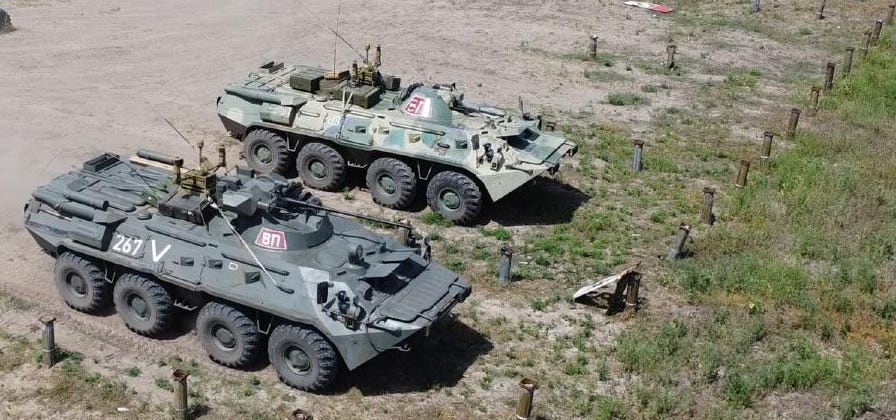David Axe Forbes Staff I write about ships, planes, tanks, drones, missiles and satellites. Following Click to save this article. You’ll be asked to sign into your Forbes account.
Got it Nov 29, 2023, 08:08pm EST Share to Facebook Share to Twitter Share to Linkedin Russian BTR fighting vehicles with RP-377 jammers on their hulls. Russian defense ministry photo Russian marines rightly are terrified of Ukrainian drones. They, like other Russian troops, are trying everything they can to shoot down, ground and deflect the tiny, explosives-laden drones.
But not every improvisation works. It’s increasingly apparent Russian forces are strapping small RP-377 radio-jammers, designed to block the signals that detonate radio-triggered roadside bombs, to tanks and fighting vehicles in the hope of blocking the signals that control speedy first-person-view drones. It also is increasingly apparent the RP-377 doesn’t work very well against FPV drones.
Indeed, there’s an entire subgenre of darkly-ironic videos circulating on social media depicting Ukrainian drones blowing up Russian vehicles sporting these do-it-yourself drone-jammers. Thematically, the videos are similar to those depicting Ukrainian forces blowing up Russian GPS-jammers with— you guessed it —GPS-guided bombs. An ungainly T-80BVM tank belonging to a Russian naval infantry brigade—either the 155th Brigade or 40th Brigade—illustrates the Russians’ drone dilemma.
The tank sports DIY cage armor that, while potentially interfering with the turret’s traverse, at least should offer some protection from exploding drones. What’s weirder is the RP-377 radio-jammer that the tank wears on its rearmost cage armor. The RP-377 is a portable jammer that the Kremlin developed to scramble enemy communications and protect infantry and vehicles from improvised explosive devices.
IEDs are a big problem in Russia’s irregular wars in places such as Syria. They’re less of a problem in Ukraine, where most of the combat pits regular forces against regular forces. But more and more Russian vehicles are showing up on the Ukraine front line with RP-377s bolted to their hulls.
The jammers probably aren’t there to defeat IEDs. It’s apparent the Russians hope the RP-377s will defeat drones . In principle, a remote IED and a drone equally are vulnerable to radio-jamming.
And following tests in 2020, Russian troops from the Eastern Military District claimed their RP-377s helped to suppress unmanned aerial vehicles. In fact, many drones boast frequency-hopping controls or autopilots that can mitigate the effects of radio-jamming. Hence the many successful drone strikes on vehicles sporting add-on RP-377s .
Perhaps most ironically, a couple of weeks ago a Ukrainian FPV drone barreled toward an RP-377-equipped Russian BMP fighting vehicle and struck it . . .
on its RP-377 . Follow me on Twitter . Check out my website or some of my other work here .
Send me a secure tip . David Axe Editorial Standards Print Reprints & Permissions.
From: forbescrypto
URL: https://www.forbes.com/sites/davidaxe/2023/11/29/the-russians-are-bolting-diy-drone-jammers-onto-their-vehicles-the-ukrainians-are-blowing-them-up–with-drones/



